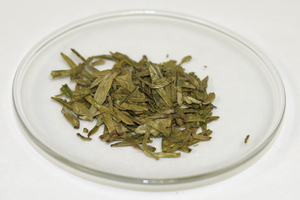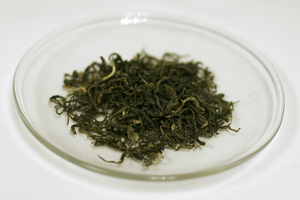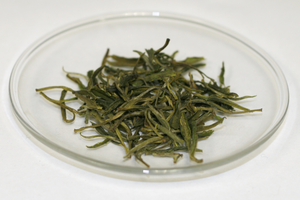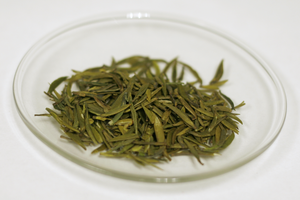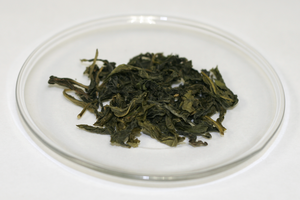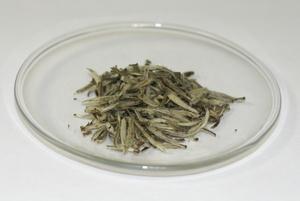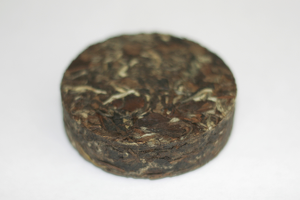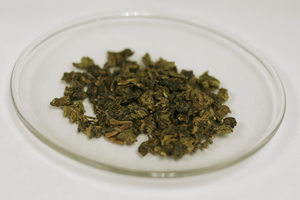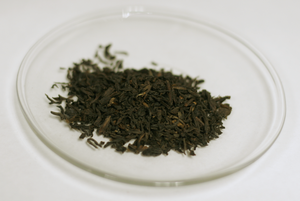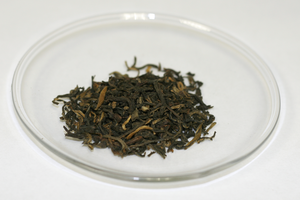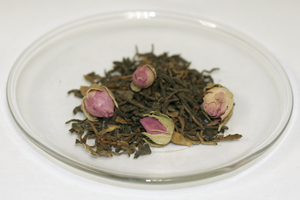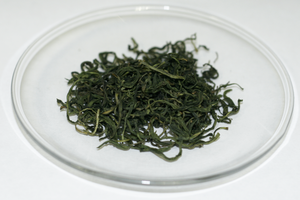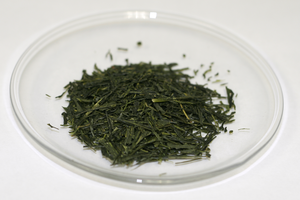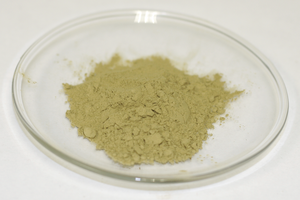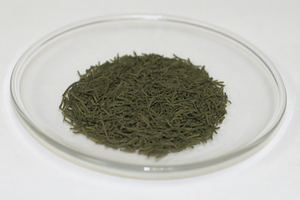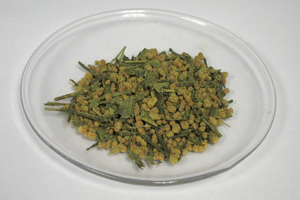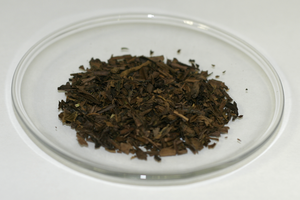 |
|
|
Chinese Green Tea
龍井茶
lóngjīng chá
Dragon well tea
This is one of the most popular Chinese green teas and is readily identified by its wide, flat leaves. It has a clear flavor and a slight acidic taste compared to other green teas. While the tea pictured here was actually purchased in Zhejiang province, it should be noted that most tea labelled as lóngjīng is not from Zhejiang province, although the taste should be very similar. (Note: buy fresh and freeze when not using or the taste will not be good.)lóngjīng chá
Dragon well tea
Steep 3 tsp at 190 °F for 6 minutes.
碧螺春
bìluóchūn
Green-jade spiral spring
Another very popular green tea. The taste is a rich green tea flavor, with a slight earthy bitterness.bìluóchūn
Green-jade spiral spring
Steep 3 tsp at 190 °F for 6 minutes. This will be a little light to avoid the bitterness (which is apparently desireable).
黄山毛峰
huángshān máofēng
Yellow mountain fur peak
A well-known tea, these young leaves have a thin, clear flavor that is reminiscent of lóngjīng. Huángshān máofēng should have two leaves attached to a stalk, rather than just the individual leaves.huángshān máofēng
Yellow mountain fur peak
Steep 3 tsp at 190 °F for 10 min.
竹心香
zhŭxīnxiāng
Bamboo-heart fragrance
This tea has an wonderful smell and a rich, warm, botanical, green tea flavor to match.zhŭxīnxiāng
Bamboo-heart fragrance
Steep 3 tsp at 190 °F for 6 min.
包種茶
bāozhŏng chá
Wrapped-kind tea
Also known as “pouchang”, this tea is slightly in-between green tea and oolong tea. It has a darker flavor than green tea, with a slight minty taste and a hint of oolong flavor.bāozhŏng chá
Wrapped-kind tea
Steep 3 tsp at 212 °F for 9 min. Steeping at a lower temperature misses flavor.
白茶
bái chá
White tea
White tea, also known as white green tea, is picked very young, when the leaves still have white fur on them (hence the name). It has a rich flavor unlike green tea. I initially thought it tasted like stalks, yet found that I could not stop drinking it.bái chá
White tea
Steep 3 tsp at 190 °F for 13 min. Do not brew at a higher temperature of the flavor will be bland.
龍白茶
long bái chá
Dragon white tea
This white tea is pressed into pucks and briefly fermented, which gives it a richer, more mellow flavor than white tea. Use a sharp knife to peel apart the layers.long bái chá
Dragon white tea
Steep 3 tsp at 190 °F for 6 min.
No image
Jasmine pearls
Steep as for white tea.
Other Chinese Tea
鐵觀音
tiěguānyīn
Iron goddess of mercy oolong tea
Oolong is partway cured, so it is midway between green tea (no curing) and black tea (fully cured). It is easily recognized by the balls of leaves, which uncurl when steeped. Like green tea, it is also very popular with Chinese tea drinkers and there are many varieties of it. Iron goddess oolong is particularly famous. It has a stronger and sharper flavor than green tea, with floral overtones when brewed properly.tiěguānyīn
Iron goddess of mercy oolong tea
Steep 3 tsp at 212 °F for 6 min. I have never been able to taste the floral flavor, but a friend of mine says that the time/temperature above does not produce it; perhaps a slightly lower termperature would.
Unknown Oolong
Steep 3 tsp at 212 °F for 8 minutes; err towards shorter times as it easily becomes bitter.
紅茶
hóngchá
Black tea
Black tea is the most common tea associated with China, although in Chinese it is called “red tea” due to the color of the water when brewed. It comes in many flavors as other ingredients are often added to the tea; the tea pictured here has a delicate lychee flavor.hóngchá
Black tea
Steep 2 tsp for 4 min at 190 °F. (Steeping with boiling water reduces flavor)
滇紅茶
diānhóng chá
Yunnan Gold
A relatively new tea from Yunnan province. In keeping with its name (“Yunnan red tea”), it has a black tea undertone with a carmelized, almost sweet flavor. It is graded by the number of yellow tips; the more the better.diānhóng chá
Yunnan Gold
Steep 2 tsp at 190 °F for 4 minutes. Do not oversteep or it will become bitter.
普洱茶
pŭ-ĕr chá
Pu’er tea
Yunnan has been famous for growing pu’er tea for hundreds of years. Although it ranges in methods of production, most pu’er tea is fermented. It is then usually pressed into cakes for transport; the leaves must be pried apart with a knife for consumption. Unlike other teas, pu’er tea is said to taste better with age, and it possible to buy pu-er tea over 50 years old. The pu’er tea pictured here has a flavor reminiscent of black tea, but lacking the interesting flavors. By itself pu’er is sort of bland, but can provide a good base for mixing with other flavors.pŭ-ĕr chá
Pu’er tea
Steep 2 tsp at 190 °F for 4 minutes. Do not oversteep or it will become bitter.
Rose pu’er tea
Steep 2 tsp of pu’er with 3-4 rosebuds for 4 minutes at 190 °F.
大紅炮茶
dàhóngpào chá
Big red cannon tea
This tea has a strong red color with a smooth, dirt-and-smoke flavor (which tastes better than it sounds). It is similar to Pu’er except with a touch of smoke.dàhóngpào chá
Big red cannon tea
Steep 3 tsp for 4 minutes at 190 °F.
枸杞茶
gŏuqĭ chá
Goji tea
Goji tea is not a true tea (camellia sinensis), as it is the leaves of the goji-berry plant grown in northwestern China. It tastes similar to green tea, but has a touch of spinach flavor as well, which gives a richer taste than actual green tea. My variety is also slightly salted.gŏuqĭ chá
Goji tea
Rinse with hot water, then steep 3 tsp at 200 °F for 5 minutes.
苦丁茶
kŭdīng chá
(Bitter stick tea)
This is a fairly rare tea; many native Chinese are unfamiliar with it. Strictly speaking, it is not tea (camellia sinensis) at all, but leaves of a tree (the ilex kudingcha leaves are pictured here). It brews a bright green liquid that is very bitter, with a sweet aftertaste. It is also said to have medicinal properties such as curing headaches and coughs. If you like bitter melon, you might like this tea.kŭdīng chá
(Bitter stick tea)
Steep 5 sticks at 190 °F for 4 min.
八寶茶
bābăochá
Eight-treasure tea
Bābăochá is a popular drink among the Hui people in northwestern China, made of dried jujube (Chinese dates), longan, apricot, gouqi berries, white raisins, rock sugar, sesame seeds, and tea (in this case, oolong). It has a rich, sweet, dark fruity taste. When served individually, it is served in a teacup with a lid, so that it is easier to avoid drinking the ingredients.bābăochá
Eight-treasure tea
To prepare, boil 1 qt of water, then steep for 10 minutes or so. The ingredients need not be removed (and, indeed, will improve the flavor). For a stronger flaver, reduce the amount of water. Several refills are possible, particularly when served in a teacup, but additional sugar may be needed.
Japanese Tea
煎茶
sencha
A middle- to high-grade green tea; it is used for day-to-day drinking. Tastes mostly like grass. The sencha pictured is high-grade sencha and has a very clear and well-defined grass flavor.sencha
Steep 2 tsp at 190 °F for 6 min (although this is a bit weak, and 3 tsp is slightly bitter)
抹茶
matcha
Powdered green tea from young leaves. It is the fairly expensive and is used for the Japanese tea ceremony. It also flavors other products such as green tea ice-cream and green tea KitKat bars (occasionally available in Japan).matcha
kokeicha
Steep 2 tsp at 203 °F for 2 minutes. Do not oversteep or the grass flavor will be intolerable.
玄米茶
genmaicha
Sencha with roasted rice, which gives it a lovely warm flavor. Sometimes it is dusted with matcha, which in my opinion often serves as an attempt to cover up a poor quality sencha (or the lower grade bancha, as I suspect is the case in the genmaicha pictured here).genmaicha
Steep 3 tsp at 190 °F for 6 min.
ほうじ茶
houjicha
Roasted green tea. It tastes dark and acerbic.houjicha
Steep 3 tsp at 190 °F for 6 min.
麦茶
mugicha
This refreshing drink is made from roasted barley and usually drunk cold in the summertime. Unlike actual tea, which is never good in tea bags, mugicha always comes in bags. (The mugicha pictured here fits on top of the glass saucer shown in the other pictures)mugicha
Steep by simply placing the bag in cold water for 5 or 10 minutes until squeezing the bag no longer darkens the water.
